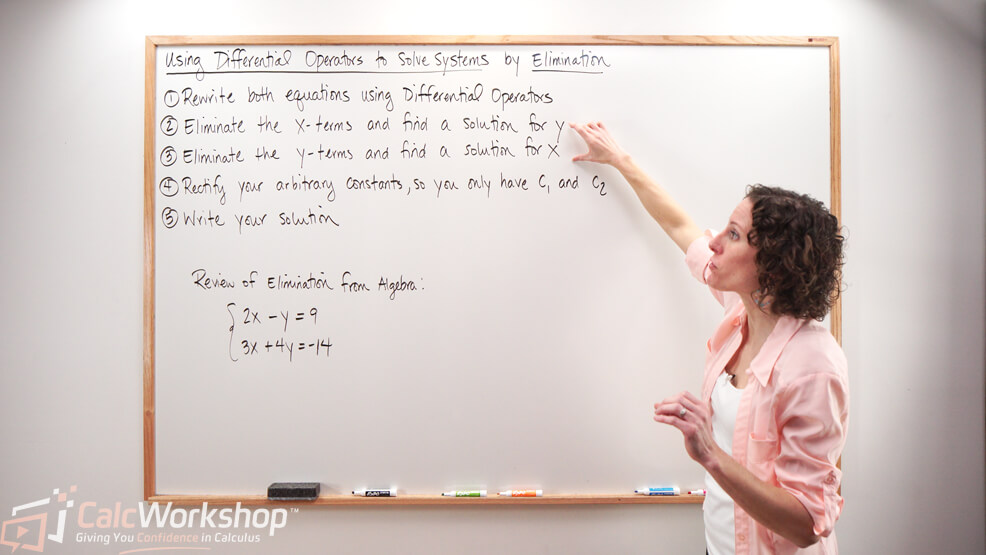Did you know that an operator, in the mathematical sense, is a means of converting one function into another?

Jenn, Founder Calcworkshop®, 15+ Years Experience (Licensed & Certified Teacher)
Just like the integration operation converts an integrable function into a new one.
Now, imagine using the letter
Let’s examine this further.
If
With this understanding, let’s explore how differential operators can be applied similarly to polynomials.
Applying Differential Operators
Evaluate
First, we will recognize that the first parentheses contain the differential operators, and the second is the function that we wish to differentiate.
Therefore, we will distribute the differential operators as follows.
Now we will take the appropriate derivatives.
Lastly, we combine like terms.
Okay, but now it’s time to ask ourselves why we need differential operators.
Uses of Differential Operators
There are countless reasons why differential operators are valuable, as we will see later when discussing Laplace Transforms, but for this lesson, we will dive into two main uses:
- The first is an alternative method for solving a nonhomogeneous differential equation using undetermined coefficients – the Annihilator Approach.
- And the second is that we can combine differential operators with the Elimination Method for Solving Systems of Linear Differential Equations.
The Annihilator Approach for Nonhomogeneous Differential Equations
The Annihilator Method transforms a nonhomogeneous differential equation into a homogeneous equation by applying a differential operator on both sides.
Here’s how it works:
- First, we will change the DE into one with differential operators.
- Then, we will find the complementary (homogeneous) solution,
- Next, we choose an annihilator for
- Then we form the general solution by applying the annihilator to both sides, obtaining another homogeneous equation, and removing any function that already appears in the complementary function.
- Lastly, we proceed with the method of undetermined coefficients for our newly acquired particular solution.
While this may seem like a lot of work, the process and methodology will aid us in future lessons.
In fact, the annihilator approach is very similar to the method of variation of parameters, which we will see in our next video, and the ability to transform one function into another is the goal of Laplace Transforms.
So, while it may be tedious, it has a purpose. I promise!
Solving Systems of Linear Differential Equations by Elimination
Alright, so not only can differential operators help us solve nonhomogeneous differential equations, but they can assist us in solving systems of linear differential equations by elimination.
The premise is that we will combine our knowledge of algebraic principles of elimination of variables with our skills and knowledge of solving homogeneous and nonhomogeneous differential equations to solve systems by elimination.
Example: Using the Elimination Method with Differential Operators
For example, solve the following system using Differential Operators
First, we will change our system of DEs into operator notation.
Looking at our two equations, let’s eliminate the y-term by multiply the first equation by -1 and the second by
Now we will add these equations together just like we would when solving a system using the elimination method.
Okay, so now we just need to simplify a bit.
Alright! Next, we need to solve for our homogenous
Which means our homogenous solution for
Now we need to find our particular solution,
But this matches one of our homogeneous solution terms, so let’s multiply by
Now, we take the necessary derivatives (i.e., you will need to use the product rule)
Next, we substitute back into our differential equation
So, our particular solution for
Lastly, it’s time to write the general solution for
Now, it’s time to find the general solution for
Plug these equations back into our second differential equation and solve for
And our general solution to the system of differential equations are:
Wow! That was crazy, right?!
Good thing there’s a trick to finding the particular solution that we’ll explore in the video.
Next Steps
As you delve into this topic and explore the associated learning materials, you can expect to unlock a wealth of knowledge and benefits. Here’s what you’ll gain from the experience:
- Gain a deeper understanding of differential operators and their applications in various mathematical scenarios, boosting your problem-solving skills.
- Learn the Annihilator Approach, a valuable method for solving nonhomogeneous differential equations, which will expand your repertoire of techniques for tackling complex equations.
- Discover how to use differential operators to solve systems of linear differential equations by elimination, enabling you to handle even more intricate mathematical systems.
- Gain hands-on experience with examples and tips, ensuring that you not only understand the theory but can also apply it in practice.
- Build a strong foundation for future lessons on Laplace Transforms and other advanced mathematical topics, setting you up for success in your studies.
It’s action-packed, so let’s get to it.
Video Tutorial w/ Full Lesson & Detailed Examples

Get access to all the courses and over 450 HD videos with your subscription
Monthly and Yearly Plans Available
Still wondering if CalcWorkshop is right for you?
Take a Tour and find out how a membership can take the struggle out of learning math.